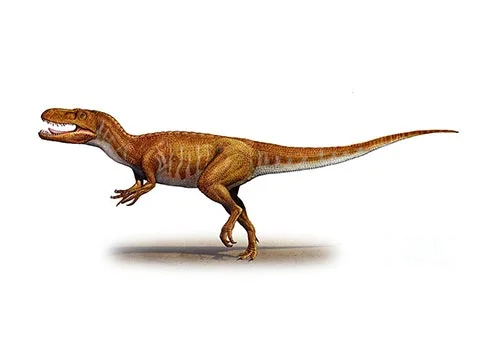Afrovenator (African-hunter)

Afrovenator, also known as “African hunter,” was named by paleontologist Paul Sereno, Jeffrey Wilson, Hans Larsson, Didier Dutheil, and Hans-Dieter Sues in 1994. This carnivorous dinosaur lived during the Early Cretaceous, approximately 132-121 million years ago. Afrovenator was a Large Theropod, estimated between 7-8 meters in length. Afrovenator fossil remains were found in Africa, Niger, Abaka, Tiouraren Formation, shedding light on the ancient ecosystems of this region and it is offering valuable insights into the prehistoric world and the evolution of Large Theropod dinosaurs.
Af-ro-vee-nay-tor
Paul Sereno, Jeffrey Wilson, Hans Larsson, Didier Dutheil, and Hans-Dieter Sues – 1994
Afrovenator Facts
When we think of the mighty predators of the dinosaur world, our minds often drift to the familiar names like Tyrannosaurus rex and Velociraptor. However, there is an ancient hunter that once prowled the African continent, leaving its mark on the pages of prehistory—the Afrovenator, also known as the “African hunter.” Named by a team of paleontologists led by Paul Sereno, Jeffrey Wilson, Hans Larsson, Didier Dutheil, and Hans-Dieter Sues in 1994, Afrovenator offers us a glimpse into the fascinating world of large theropod dinosaurs during the Early Cretaceous period.
Afrovenator, a carnivorous dinosaur, roamed the African landscape approximately 132-121 million years ago, during the Early Cretaceous. In a time when dinosaurs ruled the Earth, Afrovenator stood as a formidable predator of its domain.
Estimated to reach lengths between 7-8 meters, Afrovenator was a sizeable carnivore. Its anatomy included sharp teeth, powerful jaws, and strong limbs—features that made it an efficient hunter. While not as famous as some of its theropod relatives, Afrovenator possessed the tools necessary to thrive in its ecosystem.
Fossil remains of Afrovenator were discovered in Africa, specifically in Niger, within the Abaka region and the Tiouraren Formation. These findings provide crucial insights into the ancient ecosystems of Africa during the Early Cretaceous and the unique biodiversity that once flourished on this continent.
As a carnivore, Afrovenator played a significant role in shaping the food web of its time. Its adaptations for predation, including its sharp teeth and claws, tell the story of a relentless and efficient hunter that preyed upon other dinosaurs and creatures of its era.
Afrovenator contributes valuable information to our understanding of the evolution of large theropod dinosaurs. Its unique characteristics and ecological role offer insights into how these apex predators diversified and adapted to different environments over millions of years.
Afrovenator, the “African hunter,” though not as renowned as some of its dinosaur counterparts, holds a special place in the annals of paleontology. Its discovery in Africa’s Tiouraren Formation has significantly enriched our knowledge of prehistoric life on the African continent during the Early Cretaceous. This large theropod dinosaur provides crucial insights into the ancient ecosystems of Africa and the evolutionary journey of formidable carnivorous dinosaurs.
As paleontologists continue to unearth more about Afrovenator and its prehistoric world, we gain a deeper appreciation for the intricate tapestry of Earth’s history. Each discovery reminds us of the awe-inspiring diversity of life that has inhabited our planet over millions of years, with Afrovenator serving as a testament to the grandeur of Africa’s ancient past.



